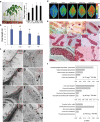Advances in transport and toxicity of nanoparticles in plants
- PMID: 36864504
- PMCID: PMC9983278
- DOI: 10.1186/s12951-023-01830-5
Advances in transport and toxicity of nanoparticles in plants
Abstract
In recent years, the rapid development of nanotechnology has made significant impacts on the industry. With the wide application of nanotechnology, nanoparticles (NPs) are inevitably released into the environment, and their fate, behavior and toxicity are indeterminate. Studies have indicated that NPs can be absorbed, transported and accumulated by terrestrial plants. The presence of NPs in certain edible plants may decrease harvests and threaten human health. Understanding the transport and toxicity of NPs in plants is the basis for risk assessment. In this review, we summarize the transportation of four types of NPs in terrestrial plants, and the phytotoxicity induced by NPs, including their impacts on plant growth and cell structure, and the underlying mechanisms such as inducing oxidative stress response, and causing genotoxic damage. We expect to provide reference for future research on the effects of NPs on plants.
Keywords: Absorb; Nanoparticles; Phytotoxicity; Plants; Transport.
© 2023. The Author(s).
Conflict of interest statement
The authors declare no competing financial interest.
Figures





Similar articles
-
Fabricated nanoparticles: current status and potential phytotoxic threats.Rev Environ Contam Toxicol. 2014;230:83-110. doi: 10.1007/978-3-319-04411-8_4. Rev Environ Contam Toxicol. 2014. PMID: 24609519 Review.
-
Nanoparticle-induced pulmonary toxicity.Exp Biol Med (Maywood). 2010 Sep;235(9):1025-33. doi: 10.1258/ebm.2010.010021. Epub 2010 Aug 18. Exp Biol Med (Maywood). 2010. PMID: 20719818 Review.
-
Nanoparticle-based toxicity in perishable vegetable crops: Molecular insights, impact on human health and mitigation strategies for sustainable cultivation.Environ Res. 2022 Sep;212(Pt A):113168. doi: 10.1016/j.envres.2022.113168. Epub 2022 Mar 26. Environ Res. 2022. PMID: 35346658 Review.
-
Unseen threats in aquatic and terrestrial ecosystems: Nanoparticle persistence, transport and toxicity in natural environments.Chemosphere. 2025 Aug;382:144470. doi: 10.1016/j.chemosphere.2025.144470. Epub 2025 May 15. Chemosphere. 2025. PMID: 40378499 Review.
-
Plants and rhizospheric environment: Affected by zinc oxide nanoparticles (ZnO NPs). A review.Plant Physiol Biochem. 2022 Aug 15;185:91-100. doi: 10.1016/j.plaphy.2022.05.032. Epub 2022 May 27. Plant Physiol Biochem. 2022. PMID: 35667318 Review.
Cited by
-
Features of Copper and Gold Nanoparticle Translocation in Petroselinum crispum Segments.Nanomaterials (Basel). 2023 May 28;13(11):1754. doi: 10.3390/nano13111754. Nanomaterials (Basel). 2023. PMID: 37299657 Free PMC article.
-
Nanoparticles in Plant Cryopreservation: Effects on Genetic Stability, Metabolic Profiles, and Structural Integrity in Bleeding Heart (Papaveraceae) Cultivars.Nanotechnol Sci Appl. 2025 Feb 17;18:35-56. doi: 10.2147/NSA.S485428. eCollection 2025. Nanotechnol Sci Appl. 2025. PMID: 39989598 Free PMC article.
-
Unlocking the dual healing powers of plant-based metallic nanoparticles: managing diabetes and tackling male infertility challenges.Front Endocrinol (Lausanne). 2025 Jul 4;16:1482127. doi: 10.3389/fendo.2025.1482127. eCollection 2025. Front Endocrinol (Lausanne). 2025. PMID: 40687580 Free PMC article. Review.
-
Nano-Pesticides and Fertilizers: Solutions for Global Food Security.Nanomaterials (Basel). 2023 Dec 28;14(1):90. doi: 10.3390/nano14010090. Nanomaterials (Basel). 2023. PMID: 38202545 Free PMC article. Review.
-
The Resistance of Germinating Pea (Pisum sativum L.) Seeds to Silver Nanoparticles.Plants (Basel). 2025 May 23;14(11):1594. doi: 10.3390/plants14111594. Plants (Basel). 2025. PMID: 40508269 Free PMC article.
References
-
- Zhang P, Ma Y, Zhang Z. Interactions between engineered nanomaterials and plants phytotoxicity uptake translocation, and biotransformation. Berlin: Springer International Publishing; 2015.
-
- Pathakoti K, Manubolu M, Hwang H. Chapter 48 - Nanotechnology applications for environmental industry. Netherlands: Elsevier; 2018.
Publication types
MeSH terms
Grants and funding
LinkOut - more resources
Full Text Sources

